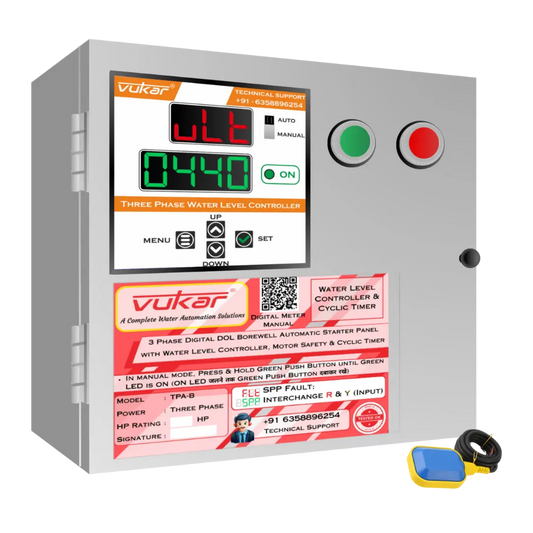Automatic Water Level Controller: A Complete Guide to Efficient Control
Mohit Vekariaशेयर करना
Are you tired of manually monitoring water tanks or worrying about motor damage due to water overflow or dry running? An automatic water level controller can be the smart solution to these common problems. By automating the process of water tank filling and motor control, this system ensures efficient water management, saving time, electricity, and preventing costly motor damage. In this comprehensive guide, we’ll explore what an automatic water level controller is, its components, benefits, and the crucial role it plays in motor protection, making your water handling hassle-free and reliable.
Understanding Automatic Water Level Controllers
What is an Automatic Water Level Controller?
An automatic water level controller is an electronic or mechanical system designed to regulate the water level in tanks or reservoirs without manual intervention. It automatically switches the water pump ON or OFF based on the water level detected by sensors, preventing overflow or dry running.
Core Components of the System
The primary parts include:
- Automatic water level controller sensor: Detects the water level inside the tank or sump.
- Automatic water pump controller: Manages the operation of the water pump based on sensor inputs.
- Automatic water level controller starter panel: The switching mechanism that activates or deactivates the motor.
These components function collectively as an automatic water level control system that offers a seamless, safe, and energy-efficient method of water tank management.
Types and Applications of Automatic Water Level Control Systems
Fully Automatic vs. Semi-Automatic Controllers
A fully automatic water level controller operates without any user intervention, using advanced sensors and relays to maintain optimal water levels. In contrast, semi-automatic systems might require occasional manual control but still automate significant tasks.
Common Applications
- Domestic use: Automatic water tank filling system for homes where continuous water supply is essential.
- Commercial and industrial use: Protects motors and ensures smooth operations in factories, hotels, and high-rise buildings.
- Agricultural use: Automated water irrigation and storage management, making farming more efficient.
- Municipal water management: Used in water stations and public water tanks for optimal water distribution.
Key Benefits of Installing an Automatic Water Level Controller
Water Conservation and Convenience
An automatic water overflow controller prevents wastage by stopping the motor when tanks are full, eliminating overflow risks. The system reduces water loss during dry spells or breaks, ensuring that water is used responsibly.
Motor Protection and Energy Efficiency
The automatic water motor controller includes functions such as automatic water motor starter and dry run protection. This prevents the motor from running without water, which can cause overheating and damage, thereby extending motor life and saving on costly repairs or replacements.
Other Advantages
- Reduced manual labor: No need for constant monitoring or manual switching of pumps.
- Cost-saving: Lower electricity bills due to controlled motor operation.
- Safety: Prevents electrical hazards associated with manual pump operations.
- Reliability: Consistent water supply without interruption.
How Does an Automatic Water Pump Control System Work?
Operation Mechanism
The system relies on sensors that detect water levels in the tank or sump. When the water level drops below a preset mark, the automatic water pump motor controller switches the pump ON to start filling. Once the tank reaches its maximum capacity, the controller switches the pump OFF to prevent overflow.
Role of Sensors and Switches
Varieties of sensors can be used, including float switches, capacitive sensors, or ultrasonic sensors for accurate detection. The automatic water level switch functions as a trigger point, sending signals to the controller to operate the pump accordingly.
Protecting Your Motor with an Automatic Water Level Controller
Dry Run Protection
One of the biggest concerns in water pumping systems is dry running, where the motor operates without water, leading to overheating and damage. Automatic water pump controllers integrate dry run protection to detect low water levels in the sump and shut off the motor instantly, preventing damage.
Overload and Stall Prevention
The automatic water pump control system also monitors motor load. If the motor becomes overloaded due to mechanical issues or blockage, it safely shuts the motor down, protecting the investment and avoiding costly breakdowns.
Choosing the Right Fully Automatic Water Level Controller
Factors to Consider
- Compatibility: Ensure the controller matches the pump type and motor size.
- Sensors quality: Opt for durable automatic water level controller sensors for accurate detection.
- Price: Consider the fully automatic water level controller price balanced with features and warranty.
- Advanced features: Look for additional functionalities like LED indicators, alerts, or app-based controls.
Installation and Maintenance Tips
Professional installation helps guarantee optimal functioning. Routine maintenance such as sensor cleaning and checking wiring connections ensures longevity and reliability of the automatic water tank level control system.
Innovations and Future Trends in Automatic Water Controllers
Smart Controllers and IoT Integration
Emerging solutions now pair automatic water controllers with IoT technology, allowing remote control and real-time monitoring through mobile applications. These smart systems optimize water use, alert users of faults, and offer data-driven water management.
Eco-Friendly and Energy-Saving Modules
New models focus on energy savings by integrating solar power compatibility and enhancing motor efficiency, making automatic tank filling systems more sustainable and cost-effective for residential and commercial use.
In conclusion, an automatic water level controller is an indispensable device for modern water management, offering the dual benefits of efficient water use and robust motor protection. By automating water pump control and preventing issues like overflow and dry running, these systems safeguard your equipment while providing continuous water supply. To experience hassle-free water management and protect your motor investments, explore our range of automatic water level controllers today and find the perfect fit for your needs.








